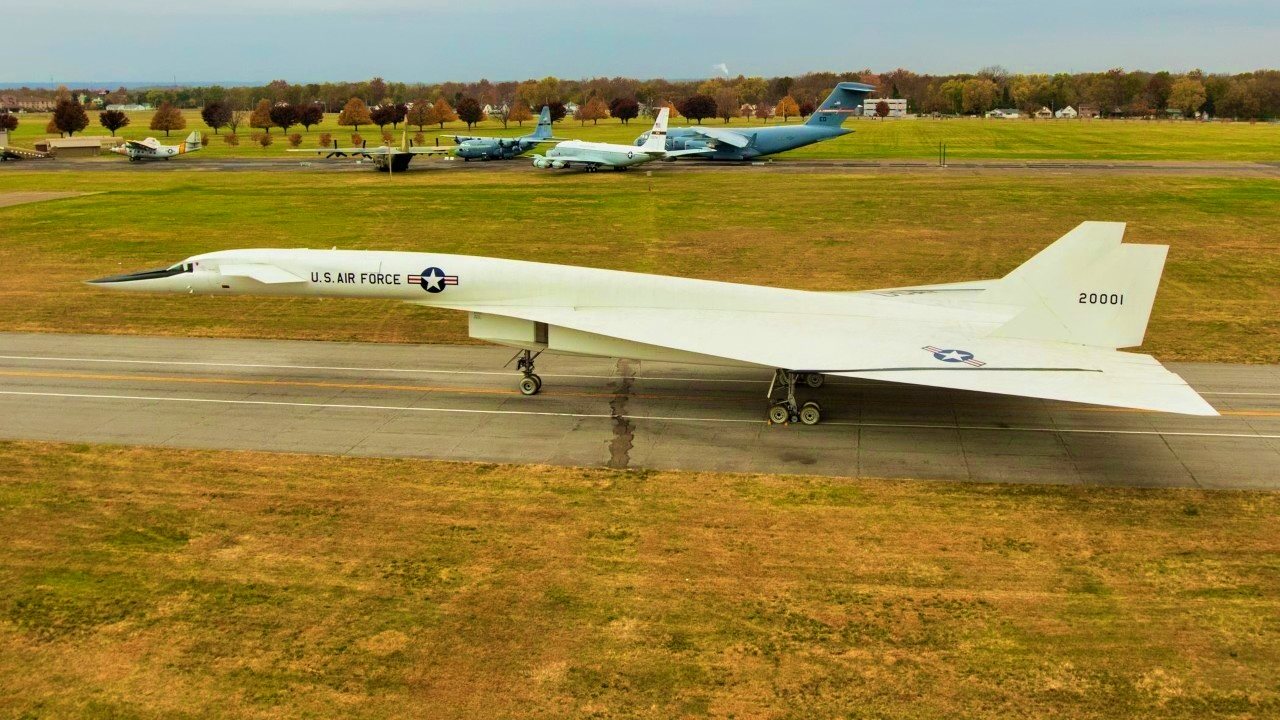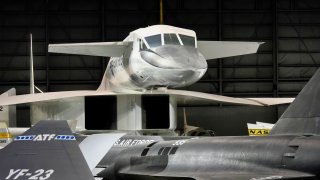XB-70 Valkyrie: The Rise and Fall of America’s Mach 3 Bomber
The North American XB-70 Valkyrie, conceived in the late 1950s, was an ambitious project to create the world's fastest and highest-flying bomber. With its futuristic design, six powerful afterburning engines, and advanced technology, the Valkyrie aimed to bypass Soviet defenses through sheer speed and altitude.
Summary and Key Points: The North American XB-70 Valkyrie, conceived in the late 1950s, was an ambitious project to create the world's fastest and highest-flying bomber. With its futuristic design, six powerful afterburning engines, and advanced technology, the Valkyrie aimed to bypass Soviet defenses through sheer speed and altitude.

-However, the advent of intercontinental ballistic missiles (ICBMs) and changing military priorities led to the program's cancellation.
-Despite its promise, only two prototypes were built, with one now displayed at the National Museum of the United States Air Force. The XB-70 remains a symbol of Cold War innovation and unfulfilled potential.
XB-70 Valkyrie: The Supersonic Bomber That Almost Was
In the late 1950s, the North American XB-70 Valkyrie looked like it had been ripped straight out of the pages of a science fiction comic book. With a sharp, angular design, six afterburning engines, and the latest targeting, navigation, and electronic warfare systems America could muster, the XB-70 was to become the world’s biggest, fastest, and highest-flying bomber in history… Until it wasn’t.
Today, the Valkyrie serves not just as a reminder, but arguably as the very pinnacle of the Cold War aviation philosophy of circumventing defenses through ever higher and faster platforms. The XB-70, like America’s famed SR-71 Blackbird and its defunct interceptor sister the YF-12, aimed to deliver on both in classic American style: by burning through budgets like jet fuel.
Born on the precipice of the missile age, the Valkyrie may have become America’s go-to nuclear deterrent, had the technology to build it been available just ten years sooner. But time waits for no man nor machine, and the Valkyrie was no exception.
A bomber design so big its fuel tanks were the size of other bombers
The program that was to eventually produce the Air Force’s B-70 supersonic bomber began in the mid-1950s, thanks to rapid advancements in the science surrounding supersonic flight. In an incredible bit of irony, the XB-70 was intended as a replacement for the brand-new-at-the-time B-52 Stratofortress, which despite having incredible range and payload capabilities, was already vulnerable to Soviet intercept fighters by the time it entered service in 1955. Now, nearly seventy years later, the XB-70 is merely one of the many bombers to fail to dethrone America’s mighty BUFF; a list that is soon to include the retiring B-2 Spirit and B-1B Lancer.
At the time, the primary threats a bomber faced during a mission were intercept fighters and anti-aircraft guns, both of which could be mitigated by simply flying higher than they could reach and faster than they could shoot. This approach, while simple in theory, created incredible engineering challenges that would lead to some of the most exotic, dynamic, and capable aircraft ever to take to the skies.
Initial designs for the XB-70 leaned on what engineers called the “brute force concept,” which called for carrying an absolutely massive amount of fuel for a long-duration subsonic flight into Soviet territory and an aerodynamic design that was optimized for high performance during a relatively “short” sprint through enemy airspace. This approach led to absolutely massive concepts that leveraged external fuel tanks that could be jettisoned once they were depleted. These “tip tanks” may have been disposable, but they were neither small nor cheap. As a 1960 Congressional report pointed out, each 191,000-pound tip-tank was approximately the same size as America’s existing B-47 Stratojet long-range bomber.
When presented to legendary Air Force general Curtis LeMay, the man behind America’s B-29 bombing raids in the Pacific Theater of World War II, he dismissed the massive 750,000-pound bomber outright.
“This isn’t an airplane,” LeMay reportedly said, “this is a three-ship formation.”
With orders to go back to the drawing board, North American’s team turned to a recently published paper by Alfred J Eggers and Clarence Syverston from the National Advisory Committee for Aeronautics. The innocuously titled document “Aircraft Configurations Developing High Lift-drag Ratios at High Supersonic Speeds” explained that aircraft that were designed from nose to tail for a single flight condition could dramatically outperform those designed to compromise between both high and low-speed flight. In fact, it went on to prove that aircraft, inlet, and engine designs meant to maintain high supersonic speeds could offer comparable fuel economy to designs meant for subsonic operation.
In other words, the paper offered the startling conclusion that the Valkyrie could reduce its fuel needs by a wide margin by adopting a specifically high-speed design and then simply keeping the pedal to the medal, so to speak.
The XB-70 Valkyrie is born
North American returned with a proposal for a bomber that was designed from the ground up to fly the majority of its missions at Mach 3 and at 70,000 feet (though some sources claim 80,000). In order to achieve and maintain these high speeds, their XB-70 was actually designed to “ride” on the shockwave it produced at supersonic speeds, using a delta-wing, slab-sided fuselage, and a large triangular intake on its belly, positioned well ahead of the bomber’s engines.
This angular intake allowed North American’s designers to intentionally position the high pressure created by the shock wave on the bottom side of the wings. In other words, the XB-70 would surf at Mach 3 on a shock wave of its own creation.
Despite its futuristic aesthetic, this new XB-70 Valkyrie wasn’t too far off in dimensions from the B-52 it intended to replace, at least when compared to the 750,000-pound behemoth originally proposed. It was longer, at 185 feet versus the B-52’s 160 or so feet, and much more narrow, with a wingspan of just 105 feet versus the B-52’s 185. It boasted a nearly 30-foot-long bomb-bay big enough to accommodate any nuclear or conventional weapons in Uncle Sam’s arsenal that was marketed as adaptable to suit Special Electronic Counter Measure (ECM) suites or reconnaissance pods to allow the high-speed bomber to serve in non-kinetic roles.
The bomber was powered by six General Electric YJ93-GE-3 afterburning turbojet engines that were rated at 30,000 pounds of thrust each with their afterburners engaged, though the engines actually produced closer to 29,000. Even if they were a bit over-sold, that still shakes out to more than 174,000 pounds of thrust, which was almost three times that of the brand-new-at-the-time B-58 Hustler, which was the world’s first operational Mach 2 bomber. These engines were lined up on the centerline of the underside of the aircraft, giving it a tail view that now looks almost reminiscent of an Imperial Star Destroyer from the Star Wars franchise, despite being thirty or so years earlier.
The XB-70 was operated by a four-man crew comprised of a pilot (and aircraft commander), co-pilot, bomb and navigation officer, and defensive systems officer. Incredibly, the cabin was designed to provide each crew member with an “encapsulated ejection seat” that would enclose around them to provide pressurized oxygen for the descent from 70,000 feet. This approach wasn’t unheard of, as a similar ejection capsule had already been designed for the B-58.
If the encapsulated seat landed in water, it worked like a boat and even came complete with a radio and fishing equipment. Documents show that the aircraft would also carry 45 pounds of survival equipment, including cold-weather clothing, a hunting rifle, and a week’s worth of rations, for each crew member—though it’s unclear if that was stowed in the ejection seat capsule or not.
This system included a provision for the pilot to remain with the aircraft in a sealed capsule while the other crew members ejected, allowing him to ensure the damaged bomber didn’t careen into populated areas or nearby American forces before ejecting himself.
The fuselage, and in fact most of the aircraft’s external surfaces, were all made using a stainless steel honeycomb-style “sandwich” approach to construction, which offered a great deal of strength and low weight. In a report penned by future president Lyndon B. Johnson and other members of the Senate Preparedness Subcommittee, North American was credited with leveraging lessons learned in development of programs like the the intercontinental supersonic SM-64 Navaho cruise missile and, of course, the hypersonic X-15 research plane in their construction methods. Wherever possible, high-strength titanium alloys were used to further cut down on weight.
The materials used in the Valkyrie’s construction were chosen specifically for their ability to manage the high heat of flight at Mach 3, well above what was commonly known as the “thermal barrier” for aircraft that leveraged aluminum in their fuselage construction. As a result, aluminum-based fighters like many of those employed by the Soviet Union couldn’t be upgraded to close this speed gap, and entirely new platforms would have to be designed.
The Valkyrie’s large delta-wing was paired with forward canards, referred to as horizontal stabilizers in some source materials, which provided lift ahead of the aircraft’s center of gravity and allowed for better trim control and a reduction in trim drag at high supersonic speeds. The canards themselves had flaps, which coupled with using the aircraft’s elevons as flaps and that large delta-wing allowed for lower speeds on take-off and landing than would otherwise be possible with such a design.


